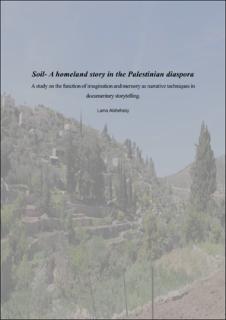| dc.contributor.advisor | Borgen, Turid | |
| dc.contributor.author | Alshehaby, Lama | |
| dc.coverage.spatial | Sweden, Palestine | en_US |
| dc.date.accessioned | 2021-03-01T14:43:10Z | |
| dc.date.available | 2021-03-01T14:43:10Z | |
| dc.date.issued | 2020-12-29 | |
| dc.identifier.uri | https://hdl.handle.net/11250/2730994 | |
| dc.description | Master's thesis in Documentary production | en_US |
| dc.description.abstract | Among the Palestinians in Sweden, homeland stories cross the frontiers of the diaspora through the memories of ancestors and the imagination of children. But how do these stories convert into documentaries that cross the spatio-temporal boundaries of the world?
This thesis examines how potential participants (social actors) in documentaries use their imagination and memory to tell homeland stories, and how imagination and memory are used in documentaries as narrative techniques. Through semi-structured qualitative interviews based on a literature review of documentary storytelling, as well as imagination and memory theories, ten interviews have been conducted; two with professional documentary makers: the filmmaker Mai Masri and the journalist Bernt Hermele. The results indicate that imagination and memory are the mainstays of documentary storytelling; memory provides documentaries with evidence of major events through the witnesses’ experiences, while imagination is about their reflection of their own reality in these events in a poetic, emotional, and rational way. Imagination and memory stem from reality and collaborate to reform this reality through documentary storytelling, which works to process reality-based individual stories creatively. This study opens novel methods to establish the link that might be missed between imagination and memory as narrative techniques in documentary storytelling. Further, it gives insight into how real people use imagination and memory to tell personal stories, and raises the documentary makers’ awareness of the potential that documentaries can implement. Future research is needed to investigate how imagination and memory are used in other completed documentary products, such as films. | en_US |
| dc.language.iso | eng | en_US |
| dc.publisher | University of Stavanger, Norway | en_US |
| dc.relation.ispartofseries | Masteroppgave/UIS-SV-IMS/2020; | |
| dc.rights | Attribution-NonCommercial-NoDerivatives 4.0 Internasjonal | * |
| dc.rights.uri | http://creativecommons.org/licenses/by-nc-nd/4.0/deed.no | * |
| dc.subject | dokumentarproduksjon | en_US |
| dc.subject | documentary storytelling | en_US |
| dc.subject | narrative techniques | en_US |
| dc.subject | identitet | en_US |
| dc.subject | diasporic Palestinians | en_US |
| dc.subject | Palestinere i eksil | en_US |
| dc.title | Soil- A homeland story in the Palestinian diaspora: A study on the function of imagination and memory as narrative techniques in documentary storytelling. | en_US |
| dc.type | Master thesis | en_US |
| dc.subject.nsi | VDP::Samfunnsvitenskap: 200::Medievitenskap og journalistikk: 310 | en_US |

